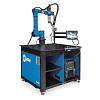Technical Liaison Manager
- FMA
- The Fabricator
- FABTECH
- Canadian Metalworking
Categories
- Additive Manufacturing
- Aluminum Welding
- Arc Welding
- Assembly and Joining
- Automation and Robotics
- Bending and Forming
- Consumables
- Cutting and Weld Prep
- Electric Vehicles
- En Español
- Finishing
- Hydroforming
- Laser Cutting
- Laser Welding
- Machining
- Manufacturing Software
- Materials Handling
- Metals/Materials
- Oxyfuel Cutting
- Plasma Cutting
- Power Tools
- Punching and Other Holemaking
- Roll Forming
- Safety
- Sawing
- Shearing
- Shop Management
- Testing and Measuring
- Tube and Pipe Fabrication
- Tube and Pipe Production
- Waterjet Cutting
Industry Directory
Webcasts
Podcasts
FAB 40
Advertise
Subscribe
Account Login
Search
Weld cracking when joining stainless and carbon steel
- By David Meyer and Rob Koltz
- September 27, 2023
We successfully weld A36 or similar grades of carbon steel to 304L or 316L stainless steel using an ER309LSi filler metal and pulsed gas metal arc welding (GMAW). Recently, we invested in automation and submerged arc welding (SAW) to reduce weld times on larger structures. Along with that integration, we have started to see solidification weld cracking, mainly in our single-pass, partial joint penetration (PJP) horizontal fillet welds. However, we have not had any issues in our flat groove welds. Any idea why this is occurring?
There could be a couple different reasons why this is happening, but you provided some valuable information that helps narrow down the issue. Let's quickly review the process and application for a better understanding.
Welding of dissimilar metals, particularly carbon steel (CS) to stainless steel (SS), has been done successfully for many decades. In fact, there is so much available information out there that it can be difficult to sort through and find the desired answer.
CS is simple compared to SS. Its basic categories include low carbon, medium carbon, high carbon, and high-strength/low-alloy, which are all weldable with caution on the high-carbon types. On the other hand, SS has three major groups based on respective microstructures that are very different from one another: ferritic, austenitic, and martensitic. Additionally, there are precipitation hardening and duplex SS, which is a blend of ferritic and austenitic, and there are subcategories to each of these groups. Many of these require special attention to weld properly for their in-service applications.
The purpose of the filler metal is to join the base materials and produce a weld microstructure resistant to cracking. Corrosion of these weld joint types is not a concern since you are welding to CS, which has no natural corrosion resistance. However, weld strength and integrity are still of high importance.
The 309 filler metal is alloyed specifically to produce a weld bead with a ferrite number (FN) between 4 and 10. The ferrite content is determined by the filler metal and dilution from the two base materials. Ferrite is a microstructure that is very resistant to weld cracking in controlled amounts. Weld beads that have FNs outside this range are very susceptible to cracking.
You mentioned that you had no cracking issues with pulsed GMAW or with SAW in groove welds, which is not surprising. However, your cracking issues began with horizontal fillet (2F) welds, and they are of the solidification type.
It appears that there is a potential for over-dilution from the base materials, specifically the CS. SAW in the 2F position can produce very deep-penetration weld beads, which may increase the dilution of the weld metal and produce an FN outside of the ideal range. Since carbon is known to be a strong austenite former, this decreases ferrite formation in the weld metal.
Other things may be contributing to the cracking issue, such as residual stress on highly constrained joints, undersized weld beads, or incorrect weld parameters. It would be very beneficial to perform a weld on test pieces and have macro-etches done to access weld penetration. Ideally, you want to keep dilution under 30% to promote a proper FN.
Pulsed or even standard GMAW does not produce welds that are excessive in penetration. Groove welds typically do not have issues either due to the nature of the welding electrode and interface with the groove bevel angles. These types of joints produce less than 30% dilution on the first pass; in subsequent passes, the dilution from the base material becomes much lower depending upon joint type and thickness.
Since PJP 2F welds only require that penetration exist slightly beyond the interface of the two base materials, you should develop weld parameters that achieve this. Oftentimes with SAW in these applications, the penetration profile is very deep into the base material, which is not necessary. Reducing the penetration profile to a depth of approximately 1/8 in. will reduce the over-dilution of the weld metal, allow for fit-up variances, and still maintain a sound PJP weld bead.
subscribe now

The Welder, formerly known as Practical Welding Today, is a showcase of the real people who make the products we use and work with every day. This magazine has served the welding community in North America well for more than 20 years.
start your free subscriptionAbout the Authors


Rob Koltz
Application Engineer
411 S. Ebenezer Rd.
Florence, 29501
636-485-2253
About the Publication
Related Companies
- Stay connected from anywhere

Easily access valuable industry resources now with full access to the digital edition of The Fabricator.

Easily access valuable industry resources now with full access to the digital edition of The Welder.

Easily access valuable industry resources now with full access to the digital edition of The Tube and Pipe Journal.
- Podcasting
- Podcast:
- The Fabricator Podcast
- Published:
- 04/30/2024
- Running Time:
- 53:00
Seth Feldman of Iowa-based Wertzbaugher Services joins The Fabricator Podcast to offer his take as a Gen Zer...
- Trending Articles
Aluminum MIG wires offer smooth feeding, reduced tangling

The role of flux in submerged arc welding performance

Three ESAB welding machines win Red Dot Awards for product design

Power source added to cobot welding system for simplified automation

Torch made for welding thin, conductive sheet metal

- Industry Events
Pipe and Tube Conference
- May 21 - 22, 2024
- Omaha, NE
World-Class Roll Forming Workshop
- June 5 - 6, 2024
- Louisville, KY
Advanced Laser Application Workshop
- June 25 - 27, 2024
- Novi, MI
Precision Press Brake Certificate Course
- July 31 - August 1, 2024
- Elgin,


























